The Ganga – Upstream Rishikesh
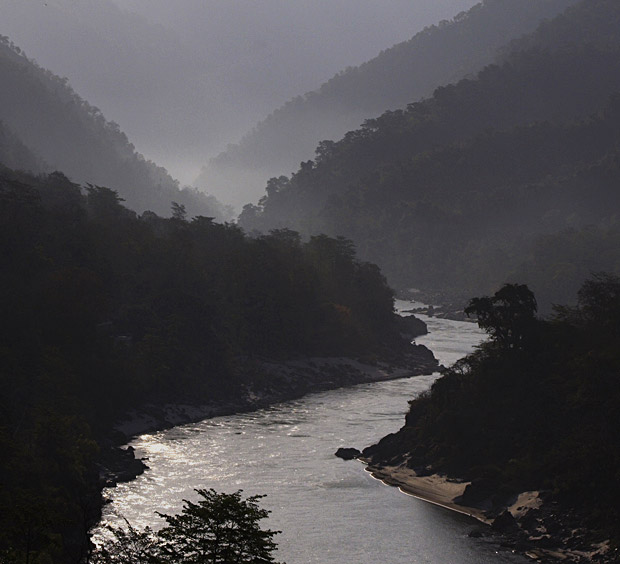

I woke up bleary eyed, took out my toothbrush and casually pulled the curtains before heading to the bathroom. One look outside the window, I threw away the toothbrush and rushed down with my tripod and camera. The view of the orange skies and sun surfacing over jagged ridges was something I did not want to miss. Toothbrush could wait.
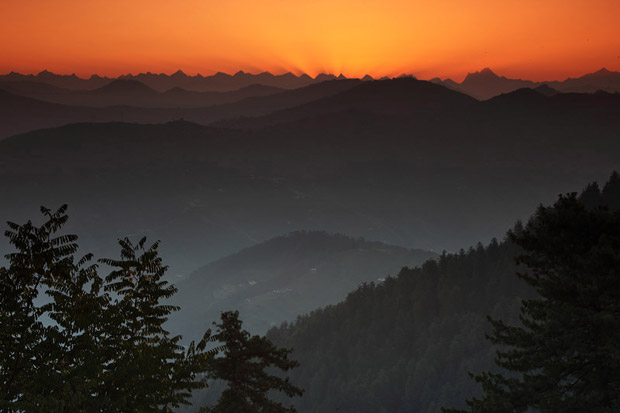
Sunrise at Mashobra
I can go on to explain how the sky changed colour, how the ridges were stacked up below a brilliant sky and how I felt exalted after witnessing the drama. But words can make the whole affair dull and stilted.
Birds arrived soon after sunrise. A small bunch of black throated tits took fancy to a tree next to me, where they hopped on from branch to branch, probably looking for breakfast. A pine tree hosted a brown thrush-like bird, which glittered on a shaft of sun rays that penetrated through the leaves. I don’t know the names of much of Himalayas bird species, but sometimes names do not matter. It can be like watching a little girl run around and giggle in a nice quiet place; it doesn’t matter what she is called.
Waking up early in the morning has its good effects on you. But on this particular day, goodness did not last beyond breakfast. I was spending my days at Mashorba, a village near Shimla on invitation from Club Mahindra. Holidaying with a small bunch of travel writing fraternity, I had four good days spent amidst the mountains. The holiday had a few dull moments too, and it was one such day of dullness. A filling breakfast later, we spent a good hour waiting to be rescued from a traffic jam in Shimla and drove further on a seemingly never ending highway past hundreds of vehicles, ugly towns, a terrible accident before finally reaching Kasauli in the middle of the day.
Kasauli was recommended as a great place to go by one of our fellow travellers who himself decided to go elsewhere that day. “It’s a nice place, go to Kasauli,” he had told us, and we had immediately finalized our plans for the day. One of us asked our driver as we approached the town, “what is there to see in Kasauli,” for which he had casually replied, “market hai, mandir hai, sunset point hai” – ‘there is a market, there is a temple, there is a sunset point’. We had arrived there on mid-day and were planning to be back in Shimla by the hour of sunset. I understood why our man who recommended Kasauli to us decided to go somewhere else himself. But not to undermine the beauty of the place, it is a quiet and nice cantonment area – a great location provided you are an army major and have a cozy house to live there. Not otherwise.
After a quick walk around Kasauli, we were back to what we were doing before – driving through a highway past hundreds of vehicles, ugly towns and waiting to be rescued from a traffic jam in Shimla.
They say you have to go through some pain to be able to appreciate all good things in life. Indeed, remaining days in Shimla were spent appreciating those good things. In the small town of Chail where we went next day, I appreciated the beauty of deodar trees growing tall on the slopes carpeted with lush grass. I watched grey wagtails hop skip and jump on the road doing what they are best at – wagging their tails! I eyed on a Eurasian Jay in the thick woods and felt happy seeing them for the first time. I argued with people for calling a magpie something else, and cursed myself later for not bothering to accept a bet and missing out on some fortune. I happily shot pictures of ridge lines, knowing fully well that some of my friends will accuse me of coming back with stereotype images. It turned out later that my friends were very predictable!
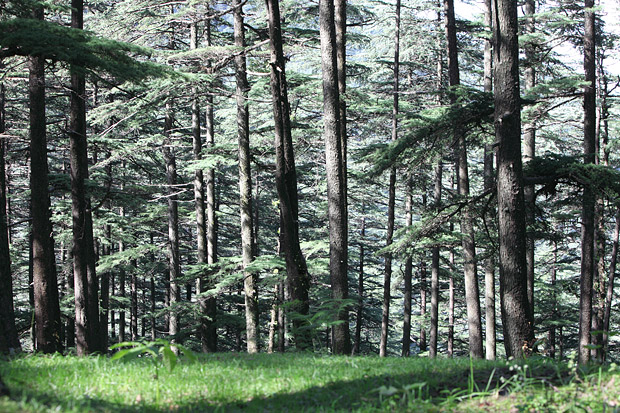
Deodars forest on the way to Chail
Chail was a place I looked forward to seeing again. I had fallen in love with its thick cedar forests when I was there three years ago (Read: my previous visit to Chail). When I first saw the market in the center of the town, it had given me an impression that there could be a large sprawl of shops out there. But I was taken by surprise to see the buildings vanish on a bend making way to another expanse of cedars. With a blanket ban on construction activity here, the quiet woods, the tall trees, the idle village had remained unchanged and unaffected by the rush of tourists since my last visit. Except for a minor addition. Someone had added an addition zero to the entry fee to Chail Palace, which then used to cost Rs.10/- Now, a fading sign at the gates said 100/- and helpfully mentioned that it can be reimbursed against accommodation charges. I reminded myself not to forget the reimbursements the next time I come here to stay at the Maharaja Suite. Just for the record, it costs about 15,000.
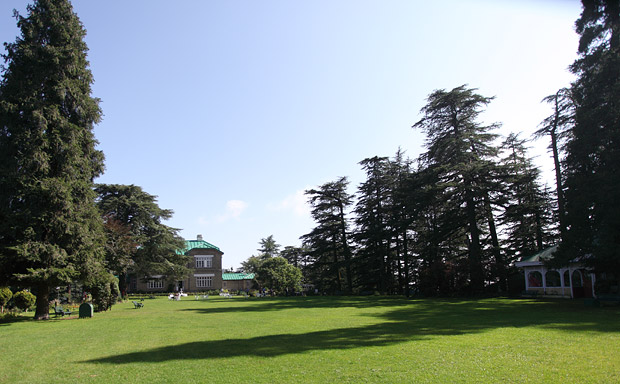
The palace built by Maharaja of Patiala in Chail
I was still thinking about Chail when we went camping in the middle of cedar trees next evening. It was a tad luxurious for a camp, but was a cozy place for a good conversation around the warmth of the fire. Much food was consumed as the well read and well travelled folks prattled on William Dalrymple, Amitav Ghosh, Gerald Durrell, Che Guevara, Twain and Dickens and more. A smattering of that night’s conversation is documented here. I am told that the chatter progressed into a raucous cacophony till small hours of the morning, but I slept peacefully in my tent dreaming of cedar trees.
Next morning, strengthened by a breakfast of best ever Aloo Parathas I have ever had, we walked through a stretch of one such cedar forest to get back to the resort, loosing our way briefly before getting back on track and resisting insistences of one of us to try and chalk out a straight line path to the resort through the steep slopes. The rewards of the walk came in the form of a few encounters, like the one with a congenial elderly shepherd who conversed fondly with his dog, a few birds and a waterfall. Not to forget is the ‘feel good’ of the deodar forests.
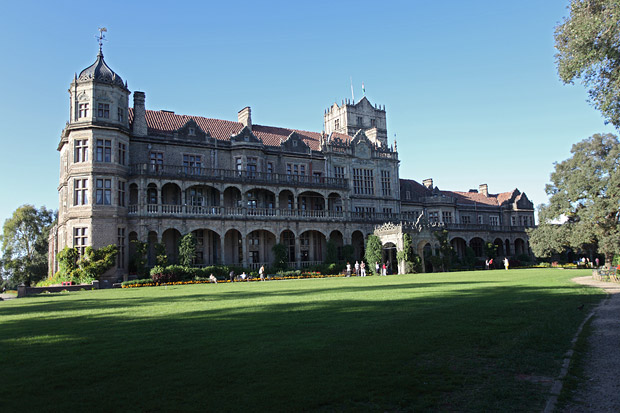
Viceregal Lodge, Shimla
Later in the day, we did what the tourists must do in Shimla – make a visit to the Viceregal Lodge and a walk up and down the mall (Read more: Walks in Shimla Mall Road, spending a day at Shimla Mall). While mall was a familiar territory, Viceregal lodge impressed and surprised me by its efficient construction and tastefully built exteriors. Raj Verma, the guide at the lodge showed us the furnishing and woodwork, electrical wiring and switches and decoratives that have survived the 121 years since the lodge was built. The foresighted architects of the lodge had implemented rainwater harvesting and had made provisions for electric wiring in the walls at a time when Shimla had no electricity at all. No wonder that the lodge is still used with very little modifications.
At the end of the touristy venture to Shimla, we were enslaved in the evening by the preparations of sous chef Vikas. I wonder what addictives he puts into his appetizers. I came to the restaurant every night with a resolve to eat very little, but never manage to stop before I could take no more. And when it comes to saying ‘thank you,’ I must not forget the tireless resort manager Mohnish.
The visit to Shimla and Mashobra ended just the way it started. We journeyed through the highway that seemed never-ending on a day that is easily the most boring one in the entire trip, even surpassing that uninspiring day when we waded past Shimla’s traffic towards Kasauli.
About Mashobra and Shimla
Mashobra is a small village, about 10km from Shimla on the Hindusthan-Tibet highway. The place has beautiful deodar forests and some great views of the mountain ranges. Read more about Shimla and surrounding places in an earlier post.
About the resort
Club Mahindra Whispering Pines Gables in Mashobra is a resort owned by Mahindra Holidays. Read more about the resort on Club Mahindra website.
I spent the September busy, if not pretending to be busy. To tell you the truth, all I did was to travel and muse about travel. A trip to Shimla kept me in in a mood for mountains for a long time, when all I did was to let my thoughts linger there. As they often say these days, I needed another holiday to get over the holiday mood.
This time the destination was the hills of Mullayyanagiri bordering the Bhadra Wildlife Sanctuary. It was going to be an inactive holiday – no intensive travel, no exploring, no photography. No activity, that’s all!
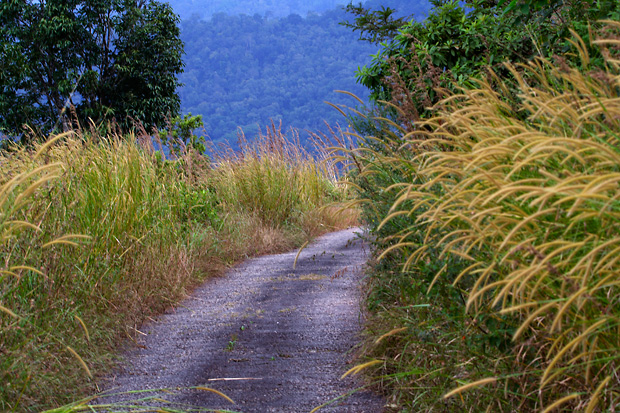
A file photo of a road near Mullayyanagiri
We had left Bangalore on a rainy afternoon and arrived at Chikmagalur at 11pm – a little later than we would have liked to. It was still drizzling as we got into the rugged jeep that took us deeper into the hills. We drove on a wet and misty road towards the hills of Mullayyanagiri with no thoughts in the mind but to quickly reach the destination and retire for the day. I would have liked it if we were on this road during the day, when one could see the lush grass on the slopes, and when weather permits, rolling hills or the plains of Chikmagalur. But not to feel bad, we were to spend two days in a coffee estate nestled in the depth of these hills.
With us in the jeep was Prasad, the cheerful driver and the estate manager Cariappa. Cariappa kept to himself first but quickly got talking when Prasad started a conversation.
‘I have been managing the plantations here for 33 years now. There are multiple estates spread in different locations around Chikmagalur…
‘I am from Ammathi at Coorg. I would like to go back to Coorg now but they would not let me..’
‘We always used to spot some or the other wild animals on the way to the estate. There was nothing today, not even a deer or boar..’
We reached the estate exactly at midnight. Having arrived in the dark, I had no clue about the location and setting of the estate. It wasn’t much different next morning either, when I woke up to see a thick fog blocking my views. But with whatever little I could see through the fog once in a while, it did seem like a beautiful place. Occasional holes in the blanket of moving fog revealed me a hill covered with thick tropical vegetation at its base and a silver-oak plantation near its grassy ridge. It seemed like there was a valley far below hidden in the fog that I would never get to see in the days I was to spend there.
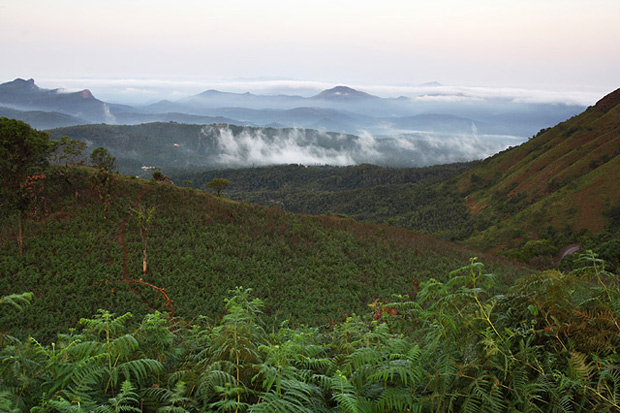
A file photo of hills near Mullayyanagiri
Within my views were the coffee plants spread on the slopes, a few buildings within the coffee estate and the dirt roads that crisscrossed the area. A silhouette of tall Silver Oaks stood parallel to each other in the fog. The trees in the estate looked wet, fresh and green, washed by three months of monsoons. The place looked mysteriously beautiful in the foggy weather, but left me in anticipation of seeing the landscape behind the depth of the fog.
Sitting back on my chair in the balcony with a book in my hand that morning, I watched the wind carry the clouds away and bringing in a fresh lot every now and then. The day was just unfolding for me, and also for the birds in the forest. I excitedly watched a barbet land on a tree very close to where I sat. A grey wagtail came closer and landed on the roof before it saw me and flew away. Malabar Parakeets made long distance flights between gaps in the canopy, squeaking loudly in flight. Red Whiskered Bulbuls inspected the nearby bushes, probably in search of worms. I watched them all, drowning cup after cup of hot filter coffee that compensated for the cold mountain breeze, occasionally glancing at my book when the outside world fell silent.
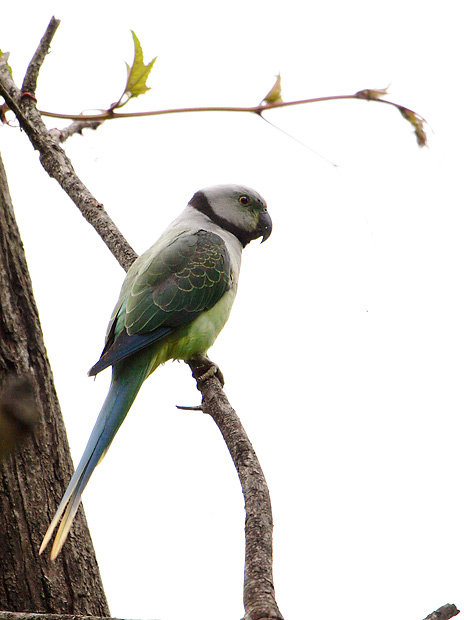
File photo of a Malabar Parakeet in Bhadra Wilderness
On a long walk past the estate later in the day, the magic of the monsoon unfolded in the slopes of the coffee country. I saw along my way, a bell-shaped purple flower with tiny water droplets on its petals that kept it fresh and beautiful. As I bent down to take a closer look, a tiny insect walked out from the heart of the flower, having had a stomach full of nectar. I peeped in closer to see two more of its kins busy feeding. A little later, I found a bee-like insect hovering over small yellow flowers, sucking the juice with ease with its long and sharp suction pipe located on its nose, which allowed it to easily delve deeper into the flower. Big butterflies of all colours hovered on the blooming flowers – one with a greenish wing with a strip of bright white, another with dark wings with a sparkling blue patch and another one bight yellow.
Up on the trees with their barks crowded with lichens, birds fluttered and sang happily. I saw a scarlet minivet that stood out in the greenery with its crimson plumage, a bunch of babblers, a flock of white-eyes and a large number of bulbuls. A hawk cuckoo sat graciously on a branch and inspected its surroundings. On a sharp curve along a steep slope where the trees were spread thinly to keep the coffee in shade, the mid-day symphony of the cicadas amplified into an almost ear-piercing clamour. Streams emerged from the slopes, appearing pristine but probably laden with pesticides from the coffee plantations sprayed before the monsoons. Fog disappeared slowly with progress of the day, revealing smooth grass laden slopes above the treeline.
A let up in the fog reveled the valley of Bhadra later in the day. In the view was thick uninterrupted greenery covered the wide basin of the valley, with hills rising again at the far end. Reflection from the waters of Bhadra Reservoir sparkled brightly near the horizon. Fog played with the scenery like a curtain raising and falling, sometimes letting in just a glimpse of the wide expanse of the vista.
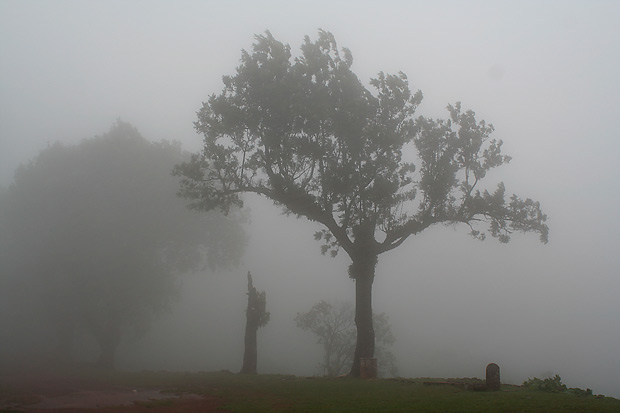
File photo – A foggy day near Mullayyanagiri
Later in the day, I spoke to Aravaind, the estate owner and former forest ranger, about the conservation efforts in Bhadra Wildlife Sanctuary. The reserve makes a good examples of rehabilitating people who once lived in the park and depended partially on the forest for livelihood. When the sanctuary was notified, the villagers in the forest were efficiently rehabilitated and every family was given arable land elsewhere in the district.
‘Some villages were deep in the forest. They had to walk for two hours to get to the nearest shop,’ Aravind told me, ‘so if they want to have some chicken for dinner, it would have been easy to go search for some fowl in the jungle than walk for four long hours.’
I have seen some results of the rehabilitation myself. In places where they had paddy fields before people moved out, you now see a bunch of bisons carelessly feasting on wild grass. Spread across an area of nearly 2,000 km², Bhadra is a tiger reserve with thick tropical forest and a population of more than 30 tigers (according 1997 census. See project tiger website). The trees here are tall and the canopy so thick, once traversing in this forest, I heard bird calls all along the way from the treetop, but never once managing to spot the origin of these sounds.
Spending another day in the foggy but pleasing weather, we drove back to Chikmagalur next day, again in darkness, again wishing that we had driven during the day.
Powered by sciolism 2019 and WordPress.